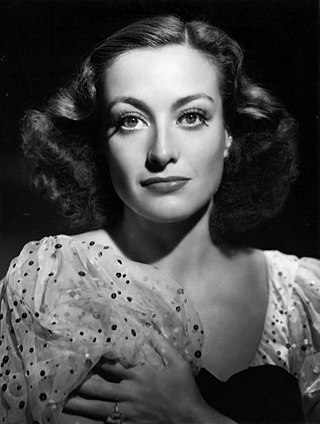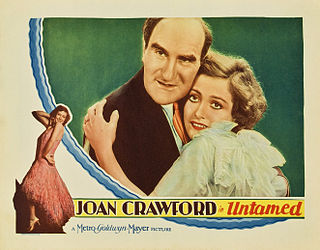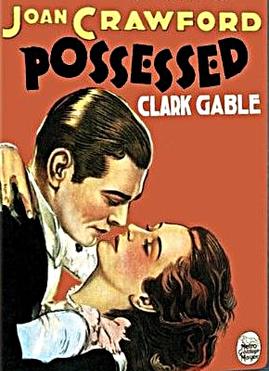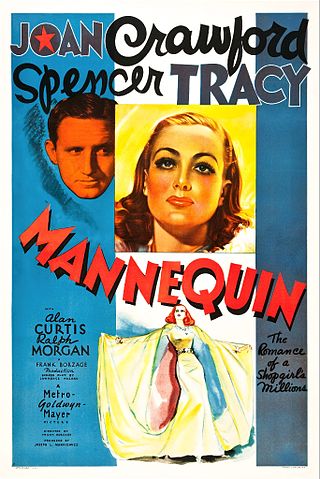
Joan Crawford was an American actress. She started her career as a dancer in traveling theatrical companies before debuting on Broadway. Crawford was signed to a motion picture contract by Metro-Goldwyn-Mayer in 1925. Initially frustrated by the size and quality of her parts, Crawford launched a publicity campaign and built an image as a nationally known flapper by the end of the 1920s. By the 1930s, Crawford's fame rivaled MGM colleagues Norma Shearer and Greta Garbo. Crawford often played hardworking young women who find romance and financial success. These "rags-to-riches" stories were well received by Depression-era audiences and were popular with women. Crawford became one of Hollywood's most prominent movie stars and one of the highest paid women in the United States, but her films began losing money. By the end of the 1930s, she was labeled "box office poison".

Mommie Dearest is a memoir and exposé written by Christina Crawford, the adopted daughter of Academy Award winning actress Joan Crawford. Officially released by William Morrow and Company on November 10, 1978, the book attracted much controversy for its portrayal of Joan Crawford as a cruel, unbalanced, and alcoholic mother, with Crawford's other twin daughters, household staff, and family friends denouncing it as sensationalized fiction. It was turned into a 1981 film of the same title starring Faye Dunaway.

Katie Scarlett O'Hara is a fictional character and the protagonist in Margaret Mitchell's 1936 novel Gone with the Wind and in the 1939 film of the same name, where she is portrayed by Vivien Leigh. She also is the main character in the 1970 musical Scarlett and the 1991 book Scarlett, a sequel to Gone with the Wind that was written by Alexandra Ripley and adapted for a television mini-series in 1994. During early drafts of the original novel, Mitchell referred to her heroine as "Pansy", and did not decide on the name "Scarlett" until just before the novel went to print. PBS has called O'Hara "quite possibly the most famous female character in American history..."

The Secret Storm is an American television soap opera that aired on CBS from February 1, 1954, to February 8, 1974. It was created by Roy Winsor, who also created the long-running soap operas Search for Tomorrow and Love of Life. Gloria Monty, of General Hospital fame, was a longtime director of the series.

William Brian de Lacy Aherne was an English actor of stage, screen, radio and television, who enjoyed a long and varied career in Britain and the United States.

Mommie Dearest is a 1981 American biographical psychological drama film directed by Frank Perry and starring Faye Dunaway, Steve Forrest, Mara Hobel, and Diana Scarwid, with supporting performances from Xander Berkeley in his feature film debut along with Rutanya Alda and Jocelyn Brando. Adapted from Christina Crawford's 1978 autobiography of the same name, the film follows her and her brother Christopher's upbringing under their adoptive mother, actress Joan Crawford, depicting her as abusive, controlling, and manipulative, prioritizing her Hollywood career over her family.

It's a Great Feeling is a 1949 American Technicolor musical comedy film starring Doris Day, Jack Carson and Dennis Morgan in a parody of what goes on behind the scenes in Hollywood movie making. The screenplay by Jack Rose and Mel Shavelson was based upon a story by I. A. L. Diamond. The film was directed by David Butler, produced by Alex Gottlieb and distributed by Warner Bros.

Untamed is a 1929 American pre-Code Metro-Goldwyn-Mayer romantic-drama film directed by Jack Conway and starring Joan Crawford, Robert Montgomery, Ernest Torrence, Holmes Herbert, Gwen Lee, and Lloyd Ingraham. The script was adapted by Sylvia Thalberg and Frank Butler, with dialogue by Willard Mack, from a story by Charles E. Scoggins.

Possessed is a 1931 American pre-Code drama film directed by Clarence Brown, starring Joan Crawford and Clark Gable and released by Metro-Goldwyn-Mayer. The film is the story of Marian Martin, a factory worker who rises to the top as the mistress of a wealthy attorney. The screenplay by Lenore J. Coffee was adapted from the 1920 Broadway play The Mirage by Edgar Selwyn. Possessed was the third of eight film collaborations between Crawford and Gable.

Forsaking All Others is a 1934 American romantic comedy-drama film directed by W.S. Van Dyke, and starring Robert Montgomery, Joan Crawford and Clark Gable. The screenplay was written by Joseph L. Mankiewicz, which was based upon a 1933 play by Edward Barry Roberts and Frank Morgan Cavett starring Tallulah Bankhead.

Mannequin is a 1937 American drama film directed by Frank Borzage and starring Joan Crawford, Spencer Tracy, and Alan Curtis. Crawford plays Jessie, a young working class woman who seeks to improve her life by marrying her boyfriend, only to find out that he is no better than what she left behind. She meets a self-made millionaire with whom she falls in love despite his financial problems.

The Ice Follies of 1939 is a 1939 American musical drama film directed by Reinhold Schünzel, and starring Joan Crawford, James Stewart, Lew Ayres and Lewis Stone.

Goodbye, My Fancy is a 1951 American romantic comedy film starring Joan Crawford, Robert Young, and Frank Lovejoy. The film was directed by Vincent Sherman and produced by Henry Blanke. Distributed by Warner Bros., the film was based on the 1948 play of same name by Fay Kanin and adapted for the screen by Ivan Goff and Ben Roberts. Reinforcing social changes brought on by World War II and movies portraying women as successful on their own, such as 1945's Academy Award-winning Mildred Pierce, the plot follows an influential Congresswoman who returns to her former college to receive an honorary degree only to find her old flame as the university president.

The Best of Everything is a 1959 American drama film directed by Jean Negulesco from a screenplay by Edith Sommer and Mann Rubin, based on the 1958 novel of the same name by Rona Jaffe. It stars Hope Lange, Stephen Boyd, Suzy Parker, Martha Hyer, Diane Baker, Brian Aherne, Robert Evans, Louis Jourdan, and Joan Crawford. The film follows the professional careers and private lives of three women who share a small apartment in New York City and work together at a paperback publishing firm. Alfred Newman wrote the musical score, the last under his longtime contract as 20th Century-Fox's musical director.

Maud Gage Baum was the wife of American children's publisher L. Frank Baum. Her mother was the suffragist Matilda Joslyn Gage. In her early life, she attended a boys' high school.

The Hoodlum Saint is a 1946 American drama film directed by Norman Taurog and starring William Powell, Esther Williams and Angela Lansbury.

Frank Jonathan Morgan is a fictional character from the Australian Channel Seven soap opera Home and Away, played by Alex Papps. Frank debuted on-screen in the serial's pilot episode and was the first character to appear. Frank is one of the five foster children of Pippa and Tom Fletcher who move to Summer Bay to begin a new life. The serial's creator Alan Bateman thought of the idea while observing the locals of a rural town in New South Wales opposing the idea of foster children living in the area. Papps was cast into the role and immediately began receiving fan mail. Frank has been played by actors Bradley Pilato and Michael Scilusa during flashback sequences.

The Man Who Lost Himself is a 1941 American comedy film directed by Edward Ludwig and starring Brian Aherne, Kay Francis and Nils Asther. Aherne plays a man who encounters his exact double and is later mistaken for the other man who is now dead. The film is based on the novel of the same name by Henry De Vere Stacpoole. The novel was also previously adapted to film in 1920. The new version shifts the setting from London of the original to New York, although it features several British actors.


















